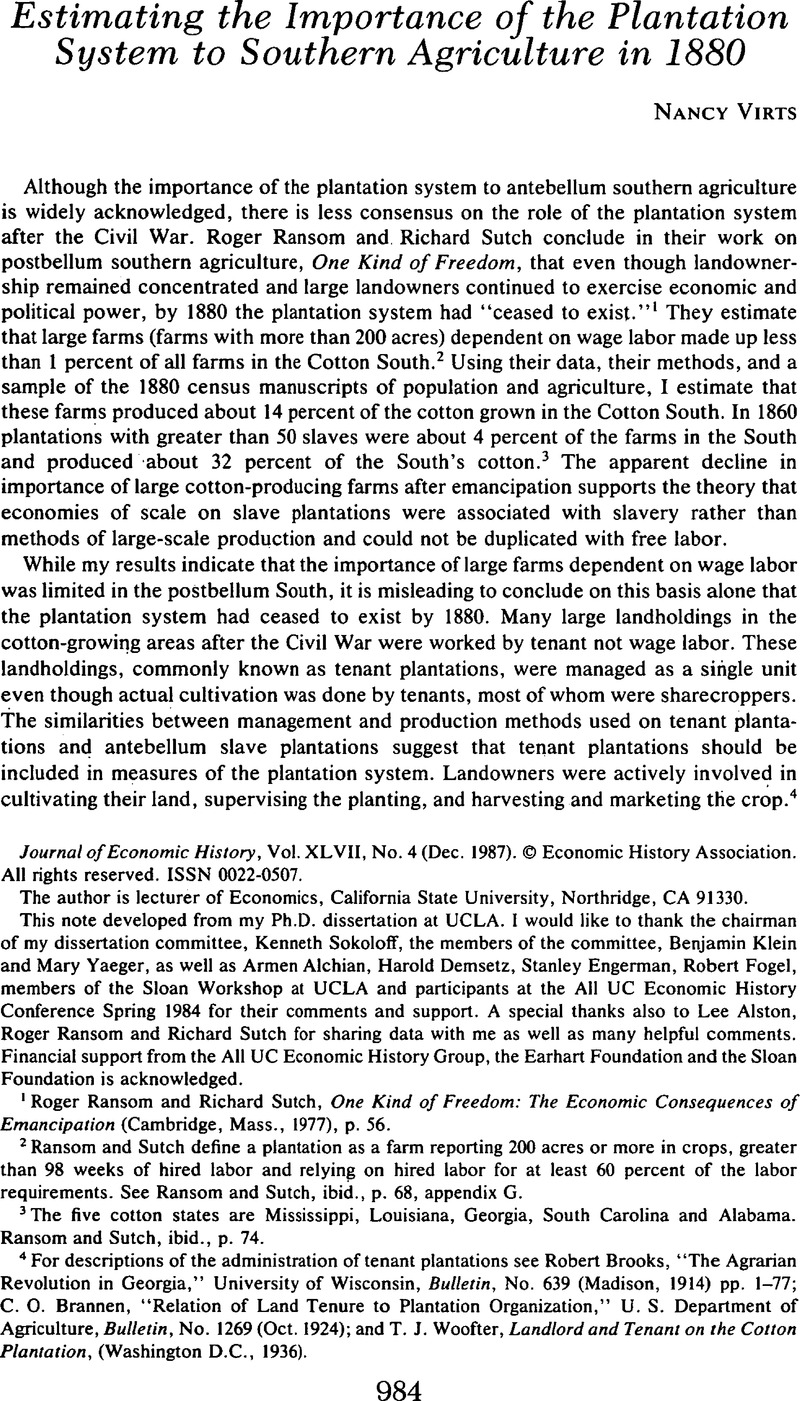Article contents
Estimating the Importance of the Plantation System to Southern Agriculture in 1880
Published online by Cambridge University Press: 03 March 2009
Abstract

- Type
- Notes and Discussion
- Information
- Copyright
- Copyright © The Economic History Association 1987
References
1 Ransom, Roger and Sutch, Richard, One Kind of Freedom: The Economic Consequences of Emancipation (Cambridge, Mass., 1977), p. 56.Google Scholar
2 Ransom and Sutch define a plantation as a farm reporting 200 acres or more in crops, greater than 98 weeks of hired labor and relying on hired labor for at least 60 percent of the labor requirementsGoogle Scholar. See Ibid., p. 68, appendix G.
3 The five cotton states are Mississippi, Louisiana, Georgia, South Carolina and AlabamaGoogle Scholar. Ibid., p. 74.
4 For descriptions of the administration of tenant plantations see Brooks, Robert, “The Agrarian Revolution in Georgia,” University of Wisconsin, Bulletin, No. 639 (Madison, 1914) pp. 1–77;Google ScholarBrannen, C. O., “Relation of Land Tenure to Plantation Organization,” U. S. Department of Agriculture, Bulletin, No. 1269 (October 1924);Google Scholar and Woofter, T. J., Landlord and Tenant on the Cotton Plantation, (Washington D.C., 1936).Google Scholar
5 For a more detailed description of the squad system see Shlomowitz, Ralph, Transition From Slave to Freedman: Labor Arrangements in Southern Agriculture, 1865–1870 (Ph.D. dissertation, University of Chicago, 1979);Google Scholar and Shlomowitz, Ralph, “Origins of Southern Sharecropping,” Agricultural History, 53 (07 1979), pp. 557–75.Google Scholar
6 See Brooks “Agrarian Revolution,” p. 66.Google ScholarPrunty, Merle, “The Renaissance of the Southern Plantation,” Geographical Review, 45 (10 1955), p. 468.Google Scholar Other references to the through-and- through system in Mississippi are Welch, Frank, “The Plantation Land Tenure System in Mississippi,” Mississippi Agricultural Experiment Station, Bulletin, No. 385 (06 1943), p. 49;Google Scholar and Pederson, Harold and Raper, Arthur, “The Cotton Plantation in Transition,” Mississippi Agricultural Experiment Station, Bulletin, No. 508 (01 1954), p. 16. Welch notes that some Mississippi plantations had been worked on the through-and-through system for long periods of time.Google Scholar
7 This procedure is described in Ransom and Sutch, One Kind of Freedom, appendix G.Google Scholar
8 Ibid.fn. 18, p. 370.Google Scholar
9 Enumerators often recorded the number of weeks during which labor was hired instead of the total number of weeks of hired labor. After examining the data Ransom and Sutch concluded that enumerators were in general consistent in the way they recorded wage data. They classified enumeration districts as either reliable or unreliable based on the average weekly wage obtained by dividing wage bill by man-weeks of labor hired. Districts where the average weekly wage was greater than $4 were classified as unreliable. However, even in cases where only the wage bill was reliably recorded it is possible to estimate the amount of labor hired. To estimate the amount of labor hired in these cases, average weekly wage rates by county were calculated using those districts coded as reliable. For farms in districts coded reliable and with information on weeks of hired labor, labor was recorded as the sum of man weeks of white and black labor divided by 52. For farms with only the wage bill recorded labor was estimated as the total wage bill divided by the average weekly wage for that county divided by 52. For more detailed description see Ransom and Sutch, One Kind of Freedom, appendix G.Google Scholar
10 For farms greater than 200 acres in the Cotton South 58 percent were in enumeration districts coded reliable; in the rest of the South 53 percent of the farms were in enumeration districts coded reliable.Google Scholar
11 See Gray, Lewis C. et al. , “Farm Ownership and Tenancy,” U. S. Department of Agriculture, Yearbook 1923 (Washington D.C., 1924), pp. 530–32.Google Scholar
12 For example see the records of enumerators from Concordia Parish Louisiana.Google Scholar
- 4
- Cited by




